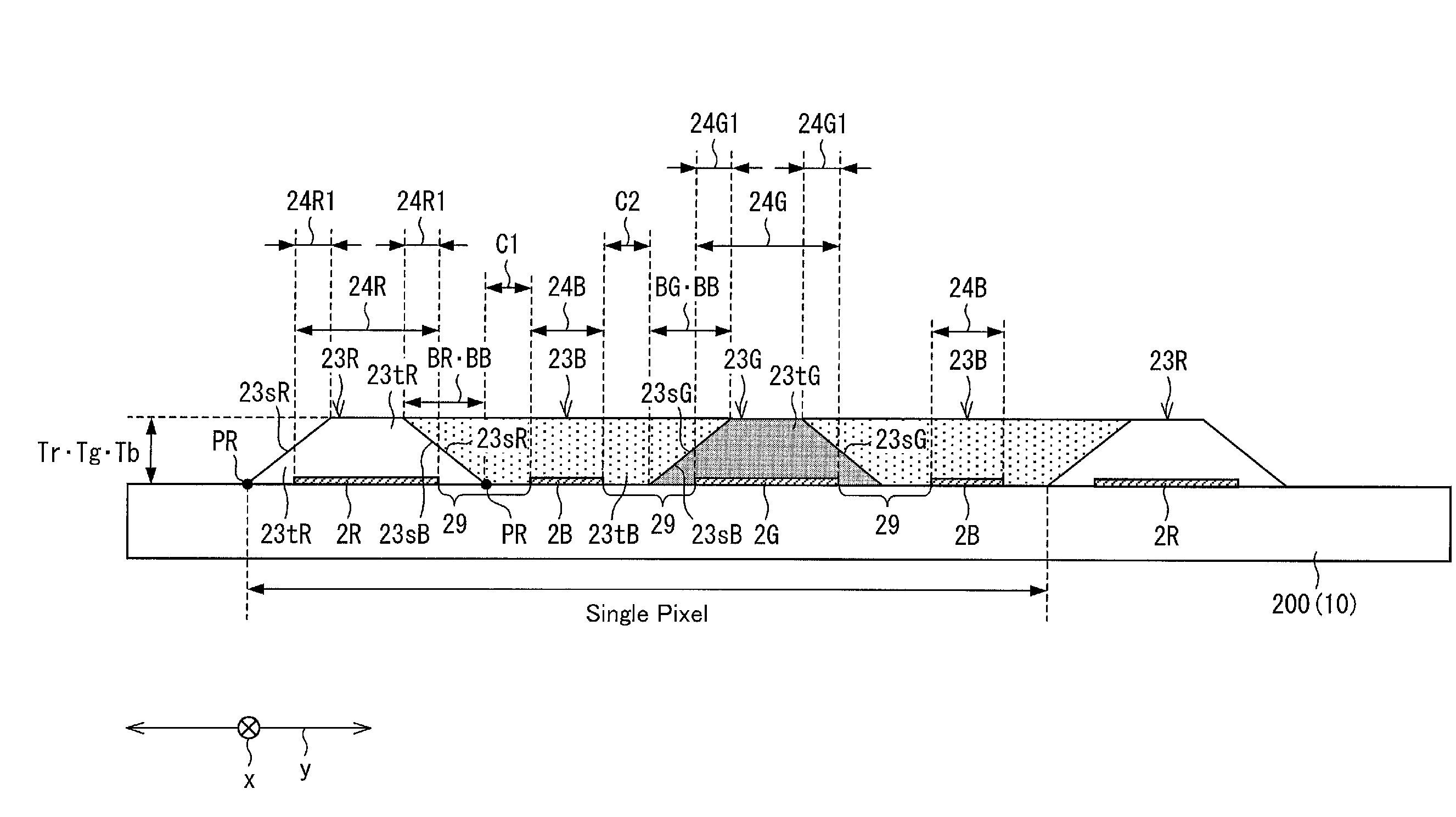Substrate to which film is formed, method for production, and organic el display device
a technology of substrate and film, applied in vacuum evaporation coating, coating, transportation and packaging, etc., can solve the problems of inability to perform high-resolution patterning, difficulty in precise patterning, misplacement of vapor deposition and color mixture, etc., to achieve the effect of suppressing the decrease of film thickness
- Summary
- Abstract
- Description
- Claims
- Application Information
AI Technical Summary
Benefits of technology
Problems solved by technology
Method used
Image
Examples
first embodiment
[0080]An embodiment of the present invention is described below with reference to FIGS. 1 through 15.
[0081]The present embodiment describes, as an example vapor deposition method involving a vapor deposition device of the present embodiment, a method for producing an organic EL display device that (i) is of a bottom emission type, that is, extracts light from a TFT substrate side, and that (ii) carries out an RGB full color display.
[0082]The description first deals with the overall configuration of the organic EL display device.
[0083]FIG. 6 is a cross-sectional view schematically illustrating a configuration of the organic EL display device that carries out an RGB full color display. FIG. 7 is a plan view illustrating an arrangement of pixels included in the organic EL display device illustrated in FIG. 6. FIG. 8 is a cross-sectional view, taken long line A-A in FIG. 7, of a TFT substrate included in the organic EL display device illustrated in FIG. 7.
[0084]As illustrated in FIG. 6,...
second embodiment
[0339]With reference to FIG. 16, the following description will discuss another embodiment of the present invention.
[0340]First Embodiment employs an arrangement in which the thicknesses Tr, Tg, and Tb of the substantially flat parts 23tR, 23tG, and 23tB of the luminescent layers 23R, 23G, and 23B are equal to each other. The present embodiment employs an arrangement in which (i) thicknesses Tr and Tg of substantially flat parts 23tR and 23tG of luminescent layers 23R and 23G (first films) are equal to each other but (ii) a thickness Tb of a substantially flat part 23tB of a luminescent layer 23B (a second film) is larger than the thicknesses Tr and Tg of the substantially flat parts 23tR and 23tG of the luminescent layers 23R and 23G (see FIG. 16).
[0341]Further, in the present embodiment, a luminescent layer 23B2 (a third film) having the same color (i.e., blue) as the luminescent layer 23B is provided on each of the luminescent layers 23R and 23G so that film thicknesses in the lu...
third embodiment
[0349]With reference to FIG. 17, the following description will discuss another embodiment of the present invention.
[0350]In Second Embodiment, the thicknesses Tr and Tg of the luminescent layers 23R and 23G, respectively, are equal to each other. In contrast, in the present embodiment, as illustrated in FIG. 17, the thicknesses Tr and Tg of the luminescent layers 23R and 23G (first film) are different from each other.
[0351]In the present embodiment, a luminescent layer 23B2 (hereinafter luminescent layer 23B2R; third film) on the luminescent layer 23R and a luminescent layer 23B2 (hereinafter luminescent layer 23B2G; third film) on the luminescent layer 23G have a substantially flat part 23tB2R with a thickness Tb2r and a substantially flat part 23tB2G with a thickness Tb2r, respectively. The thickness Tb2r of the substantially flat part 23tB2R and the thickness Tb2r of the substantially flat part 23tB2G are represented by equations 6 and 7, respectively.
Tb2r=Tb1−Tr equation 6
Tb2g...
PUM
| Property | Measurement | Unit |
|---|---|---|
| thickness | aaaaa | aaaaa |
| blue luminescent | aaaaa | aaaaa |
| size | aaaaa | aaaaa |
Abstract
Description
Claims
Application Information
 Login to View More
Login to View More - R&D
- Intellectual Property
- Life Sciences
- Materials
- Tech Scout
- Unparalleled Data Quality
- Higher Quality Content
- 60% Fewer Hallucinations
Browse by: Latest US Patents, China's latest patents, Technical Efficacy Thesaurus, Application Domain, Technology Topic, Popular Technical Reports.
© 2025 PatSnap. All rights reserved.Legal|Privacy policy|Modern Slavery Act Transparency Statement|Sitemap|About US| Contact US: help@patsnap.com



